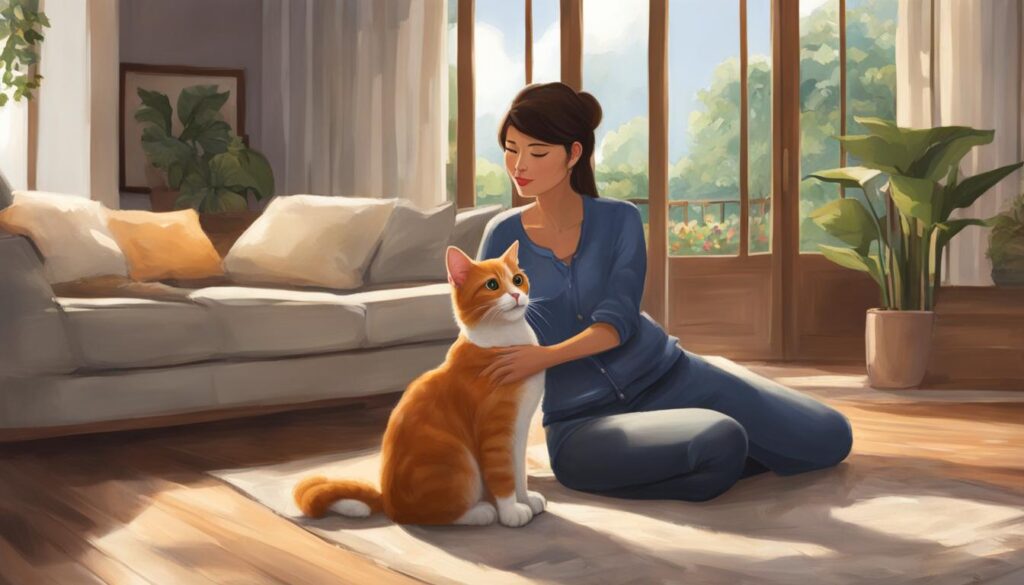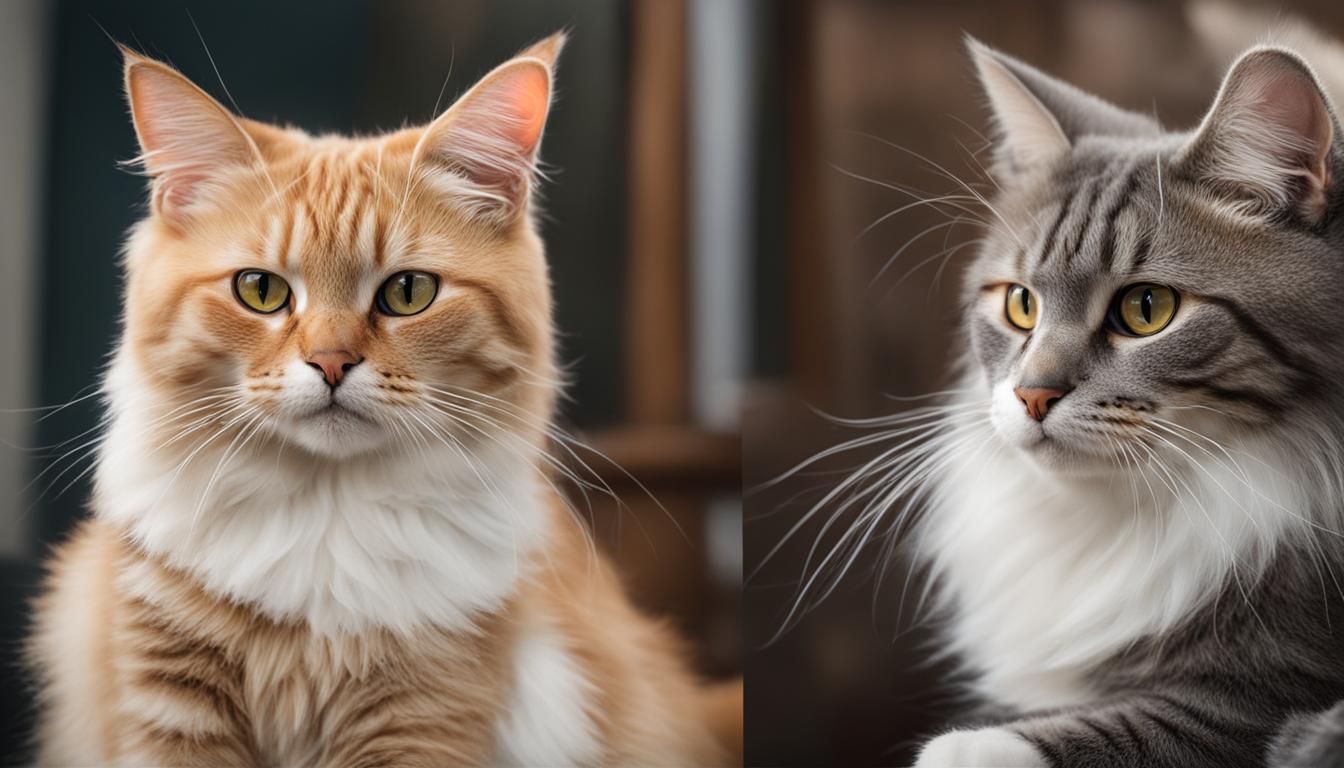The Unique World of Cat Communication: From Purring to Meowing
Welcome to our exploration of the fascinating world of cat communication! Cats have a unique language that involves both vocalizations and body language cues. By understanding how our feline friends communicate, we can deepen our bond and provide them with the care they need.
When it comes to vocalizations, cats have a remarkable repertoire. We often associate meowing with cats, but did you know that cats primarily use this vocalization to communicate with humans rather than with other cats? Meows can convey various needs and emotions, such as hunger, playfulness, or distress. On the other hand, purring is a sound associated with contentment. However, it’s important to note that cats can also purr when feeling anxious or in pain.
Decoding cat vocalizations is just one part of understanding their language. Another important aspect is interpreting their body language. Cats use their bodies to express their moods and intentions. The position of their tail, for example, can indicate confidence, agitation, or fear. Similarly, ear movements can convey curiosity or aggression. By paying attention to these non-verbal signs, we can gain valuable insights into our cat’s communication.
Key Takeaways:
- Cats communicate through vocalizations and body language cues.
- Meowing is primarily used to communicate with humans.
- Purring can indicate contentment, anxiety, or pain.
- Interpreting body language helps understand a cat’s mood and intentions.
Understanding cat communication is an essential skill for cat owners. In the following sections, we will delve deeper into the various vocalizations, body language cues, and the importance of context in cat communication. By the end of this article, you’ll be equipped with the knowledge to better understand your feline companion and strengthen your bond with them.
Decoding Cat Vocalizations
Cats have a sophisticated language of their own, using a diverse range of vocalizations to communicate their needs and desires. Understanding these vocalizations can provide valuable insights into a cat’s emotions and enable us to respond appropriately. Let’s explore the various cat vocalizations and what they signify.
Meows and Yowls
Meowing is a versatile vocalization commonly used by cats to communicate with humans. They may meow to express hunger, request attention, or seek interaction. On the other hand, yowling is a more intense and drawn-out vocalization often associated with distress or a strong desire to communicate an urgent need.
Purrs
Purring is a unique vocalization that is characteristic of contentment. Cats purr when they are relaxed and feel safe, but interestingly, they may also purr in situations of stress or pain. It’s crucial to consider other accompanying cues to accurately interpret a cat’s emotional state.
Hisses
Hissing is a warning sign of aggression or fear. When a cat feels threatened or uncomfortable, they may hiss as a defense mechanism to communicate that they need space or feel cornered.
Chirps, Trills, and Chatters
In addition to meows, yowls, purrs, and hisses, cats also use chirps, trills, and chatters to communicate different emotions. Chirping and trilling are often associated with excitement or greeting, while chattering is a vocalization that cats make when they’re frustrated or excited about something they can’t reach.
Understanding these vocalizations allows us to better interpret our cats’ emotions and strengthen our bond with them. It’s important to pay attention to the context, body language, and other accompanying cues in conjunction with vocalizations to gain a comprehensive understanding of our feline friends.
Second source
To summarize, cat vocalizations, including meows, yowls, purrs, hisses, chirps, trills, and chatters, play a vital role in cat communication. By familiarizing ourselves with these vocal cues and observing our cats’ behavior, we can nurture a stronger connection and ensure their well-being.

Interpreting Cat Body Language
Cat body language is a fascinating aspect of feline communication. By observing their tail positions and ear movements, we can gain valuable insights into a cat’s mood and intentions. Understanding these non-verbal signs is key to decoding their messages and strengthening our bond with them.
Tail Positions
The position of a cat’s tail can convey a range of emotions and attitudes. Here are some common tail positions and their meaning:
- A high and upright tail indicates confidence and a friendly disposition.
- A gently swaying tail often signifies relaxation and contentment.
- A tucked tail between the hind legs suggests agitation or fear.
By paying attention to the position of a cat’s tail, we can better understand their emotional state and respond accordingly.
Ear Movements
The movement of a cat’s ears is another important indicator of their communication. Paying attention to their ear positions can provide valuable insights into their curiosity, interest, fear, or aggression:
- Relaxed and forward-facing ears often indicate curiosity and attentiveness.
- Ears pinned backward suggest fear or aggression.
By interpreting these non-verbal signs, we can gain a deeper understanding of a cat’s intentions and emotions.

Understanding cat body language, including tail positions and ear movements, is crucial for effective communication with our feline companions. By recognizing their non-verbal signs, we can respond appropriately and build a stronger bond. Now, let’s explore the importance of context in cat communication. (“Second source:”)
Context Matters in Cat Communication
When it comes to understanding our feline companions, it is crucial to consider the context in which they communicate. Cats have a unique way of expressing their needs and emotions through a combination of vocalizations and body language cues. By paying attention to these signals, we can gain a deeper understanding of their communication and strengthen our bond with them.

Cats use different vocalizations depending on the situation. Meows, for example, can have various meanings. While a short meow may indicate a simple greeting, a prolonged meow could be a sign of hunger or the desire for interaction. By listening to the tone and duration of their meows, we can better interpret their needs.
Body language is another important aspect of cat communication. Paying attention to their interaction cues through subtle movements, such as ear positions and tail postures, can provide valuable insights into their emotions. For instance, a cat with an upright and gently swaying tail is likely feeling content and friendly, while a tucked tail indicates fear or agitation.
To summarize, understanding cat communication context is key to interpreting their vocalizations and body language accurately. By observing their interaction cues and considering the situation at hand, we can deepen our understanding of their needs and emotions. This knowledge allows us to respond appropriately and foster a stronger connection with our feline friends.
Key Takeaways:
- Cats use different vocalizations and body language cues depending on the context.
- Meows can have various meanings, such as hunger or a desire for interaction.
- Observing a cat’s body language, including ear positions and tail postures, provides valuable insights into their emotions.
- Understanding cat communication context helps us interpret their needs and emotions accurately.
Conclusion
Understanding cat communication is the key to deepening our bond with these fascinating creatures and gaining insight into their behavior. By decoding their vocalizations, such as meows, purrs, and hisses, we can better respond to their needs and emotions.
Interpreting cat body language, like tail positions and ear movements, provides valuable clues about their mood and intentions. Whether our cats are feeling content, curious, or agitated, decoding these non-verbal signs helps us understand them on a deeper level.
Context matters in cat communication, and by paying attention to the situation and their interaction cues, we can improve our understanding even further. Whether they’re communicating their hunger, desire for attention, or fear, recognizing these different communication signals allows us to respond appropriately and strengthen our bond with our furry companions.
Ultimately, by enhancing our understanding of cat communication, we can create a harmonious and fulfilling relationship with our cats. Whether they’re purring with contentment or hissing in warning, being attentive to their needs, using positive reinforcement techniques, and interpreting their communication signals will enable us to provide the love and care they deserve.
FAQ
How do cats communicate?
Cats communicate through a variety of vocalizations and body language cues. They use meowing, purring, hissing, chirping, trilling, and chattering to convey their needs, emotions, and intentions.
What does a cat’s purring indicate?
Purring is commonly associated with contentment, but it can also indicate anxiety or pain. Understanding the context and accompanying body language can help determine the true meaning behind a cat’s purring.
What do different types of meows mean?
Meows and yowls can signify hunger, playfulness, or distress. Paying attention to the tone, pitch, and intensity of the meows can help decipher a cat’s specific needs and desires.
How can I understand a cat’s body language?
Cat body language provides valuable insights into their mood and intentions. The position of the tail, ear movements, and overall body posture can indicate confidence, friendliness, fear, or aggression. Learning and observing these non-verbal signs allows for a better understanding of a cat’s communication.
Why is context important in cat communication?
Cats use different vocalizations and body language cues based on the situation. Meows and attention-seeking behaviors may indicate hunger or the desire for interaction. Understanding the context in which cats communicate helps in interpreting their needs and emotions accurately.


